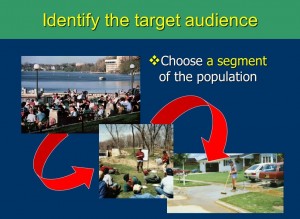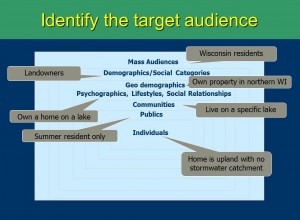Plan Navigation
Logic Model (PDF)
In PLAN, the first thing you need to do is to develop a rough idea of what you want to do and how you want to do it. Accomplish What? helps you initiate a strategy appropriate to the problem you want to solve.
Once you have the beginning of a plan, the next step is to familiarize yourself with the “community” and identify one or more target audiences.
A focus on a target audience is essential to success, according to research evaluating effectiveness of outreach programs and campaigns. Once you have identified the goal of your outreach effort, brainstorm who, specifically, could be a part of making that goal happen.
Find out as much as you can about your target audience
What is a target audience?
There are many ways to identify your target audience. It’s best to begin by breaking down your outreach goal into simpler elements. For example, you want to reduce the amount of soil that gets washed into the storm sewer after a storm event in a city. Where does that soil come from? If one source is new construction, what specific activities take place at the construction site that result in soil erosion during a storm event? Who, specifically, can influence how each of those activities is managed? For more about identifying a target audience.
Involve others in thinking through this part of your outreach plan. Stakeholder involvement builds interest, motivation, and credibility for your effort and is also likely to provide some very good advice. Other ways to gather information about the potential target audience include: surveys, focus groups, or a review of the published literature about the topic.
Find out as much as you can about your target audience:
- Use the Target Audiences navigation menu [About Research; Search Research Findings] to investigate research findings about specific audiences.
- Check to see if your target audience is one of the 15 audiences specified in our BEP research recommendations.
- Review categories in Findings by Audience to help clarify audience details of interest.
- Decide what kinds of information you need to know. Involve your target audience in deciding which characteristics are important. Depending on your education or outreach goal, you might want to know:
- Age and other demographic characteristics
- Geographical location
- Problems they want to solve
- Educational needs/gaps
- Recreational/fun interests
- Where the audience likes to get new information
- Whether the audience owns or rents the land they use
- What group activities they participate in
- Specific behavior patterns related to the outreach goal
- You may also want to select your target audience based on one or more of the characteristics listed above. People can be grouped by any one of these or other characteristics. For example, you might want to address all farmers who maintain buffer strips in riparian corridors.
- Here is an illustration of choosing a segment of a population, beginning with “Wisconsin residents” and narrowing to “people who have a home on a specific lake, who are summer residents only, and whose home is upland from the lake, with no storm water catchment area”.
 |
 |
For more information . . .
For more information about what questions to ask or what research shows about a specific target audience, BEP Research will lead you through a series of questions and links to other resources on this website. Reviewing the Findings of our target audience literature review or reading the specific articles we cite may also help you identify a target audience. For tips on how to identify and analyze the target audience, see the “Resources” section below..
RESOURCES
Getting In Step, A Guide for Conducting Watershed Campaigns – available from U.S. EPA:
- Getting in Step. A guide for Conducting Watershed Outreach Campaigns, 3rd edition, Nov 2010
- Other EPA water resources, http://www.epa.gov/owow/watershed/outreach/documents/
Western Rural Development Center publications. See especially:
- The SONDEO, a Rapid Reconnaissance Approach for Situational Assessment
- Focus Groups: A Tool for Understanding Community Perceptions and Experiences
- The Community Survey: A Tool for Participation and Fact-Finding
Wilbur, Jack. 2006. Getting Your Feet Wet with Social Marketing. A Social Marketing Guide for Watershed Programs. Utah Department of Agriculture and Food, Salt Lake City, Utah, pp. 36-45.



